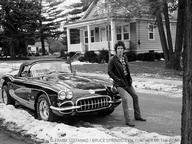Quiz Answer Key and Fun Facts
1. "Greetings from Asbury Park, NJ" was Bruce Springsteen's first release for Columbia Records. Produced by Mike Appel, Columbia attempted to promote this album as the herald of a "new Bob Dylan"; this approach nearly buried Springsteen's nacent career. Which of these was a slogan used to promote Springsteen's maiden effort?
2. The first cut on this seminal album mixes double-entendres with scenes from the amusement-park and bar-band landscape of Springsteen's New Jersey. What is the title of this great straight-ahead folksy rock song that was later covered, to great commercial success, by Manfred Mann's Earth Band?
3. The second cut on "Greetings", "Growin' Up", intersperses grand imagery with now-familiar Springsteen tropes, including a rough youth and salvation through music and escape. One of these impressive images has Springsteen finding "the key to the universe". In what very temporal nook does the writer find this celestial object?
4. The third song on "Greetings", "Mary, Queen of Arkansas", has not survived to become a consistent live favorite or get much radio play. Nevertheless, it does feature some impressive writing, including the intriguing metaphor: "You're not man enough for me to hate, but woman enough for _______"
5. The album's fourth track, "Does This Bus Stop at 82nd Street?", has been widely hailed as utterly incomprehensible, and it is indeed hard to pin down a central theme therein. That being said, it does have some great lines, including a possible allusion to Columbia's hype of Springsteen as a new Dylan: "Queen of diamonds, ace of spades, newly discovered lovers of the everglades/They take out a full page ad in the trades to announce their arrival." What actress of the past does Springsteen hail in this piece?
6. The longest, and perhaps most evocative, song on this album is "Lost in the Flood", a ballad of street violence and at times shocking religious imagery ("Nuns run bald through Vatican halls pregnant/Pleading Immaculate Conception). Who is (arguably) the central figure of this piece?
7. The album's sixth composition, "The Angel", is a slow ballad accompanied only by piano. The "angel" in question is a young woman giving her boyfriend a last kiss before being taken into a convent.
8. "Greetings'" seventh track, "For You", was also covered by Manfred Mann, albeit to less success than the other Springsteen tune he recorded. Featuring a catchy drum and organ riff, its lyrics evoke medical drama, images of Tantalus, and even the adventures of Superman. Perhaps most memorably, it also coined the marvelously perceptive phrase: "Your life was one long ________"
9. The album's penultimate track, "Spirit in the Night", is very evocative of Van Morrison musically. Lyrically, it tells the story of Springsteen's eclectic cast of characters having an uninhibited night away from the confines of authority - with mixed results. Which of these is not a character from this song?
10. The final song on the album, "It's Hard to Be a Saint in the City", is a spirited hymn to youthful bravado, opening with the protagonist announcing: "I had skin like leather and the diamond-hard look of a cobra." Which of these titles does the narrator not claim?
Source: Author
stuthehistoryguy
This quiz was reviewed by FunTrivia editor
agony before going online.
Any errors found in FunTrivia content are routinely corrected through our feedback system.

